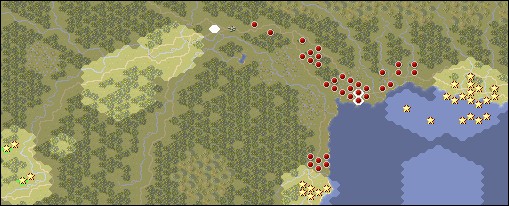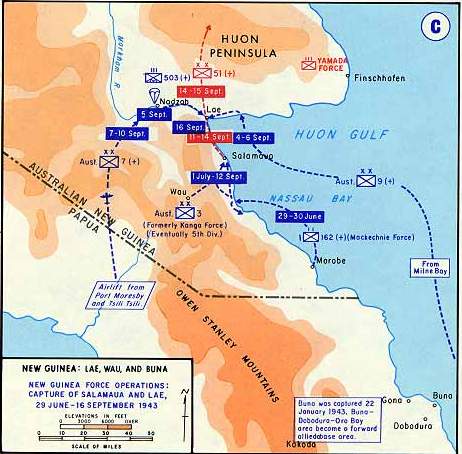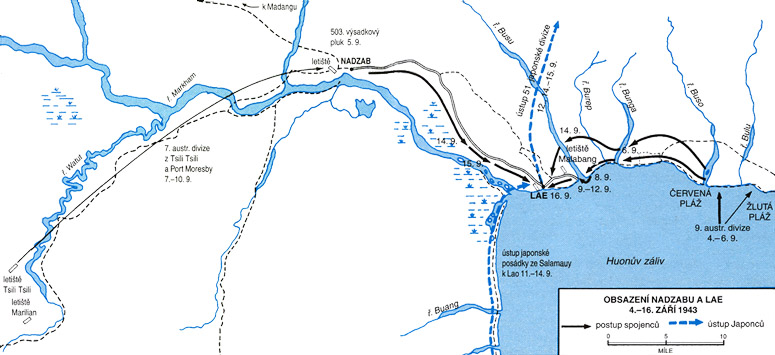 When you move the mouse pointer over the map, unit name, strength and coordinates are displayed as a label. When you press terrain button object name is displayed (city, river, sea, ...) |
Lae
4.9.1943 - 16.9.1943
PacPG: 4.9.1943 - 17.9.1943
Scenario Map:
|
|
|
Changes and corrections of map:
|
Scenario author: Scenario origin: Last revision date: |
stanny 14.6.2005 27.3.2011 |
First release: Revision released: |
4.8.2009 ( Release 01 ) 4.4.2011 ( Relase 02 ) |
| Completely new, by theme interesting scenario - air landing took place here, naval landing and ground advance too. |
Historic overview:
Article on English Wikipedia
| ||||||||||||||||||||||||||||||||||||||||||||||||||||
Game play matters:
| Campaign play: The first scenario of Australian campaign. Lose causes end of the campign. After both Major and Minor victories follows scenario Finschhafen. Scenario rarities: Within the air landing are transported by air also light guns. In fact it was even dropped on parachutes. |
Scenario data:
|
Map size: 64 x 25 hexes 14 turns, 1 day per turn Version: PacAGPG 2, Starting side: Allies, Campaign: Australian campaign, Order in campaign: 1. |
||||||||
|
||||||||
|
||||||||
|
||||||||
|
||||||||
|
Game time costingness of scenario: 13.03 % (product of units and turns numbers divided by difference between the most long and the most short scenario) |
||||||||
|
Number of Allied units: 46 units, from them are 7 core units and 39 auxiliary units 13 air units, 3 naval units and 30 ground units 4 of units are loaded to air transport and 9 to naval transport |
Transports Air/Naval: Allies - Axis 5/15 - 0/0 |
|||||||
|
Number of Axis units: 45 units 10 air units, 0 naval units and 35 ground units 0 of units are loaded to air transport and 0 to naval transport |
Initial prestige + every turn donation: Allies / Axis 300 + 0 / 398 + 49 |
|||||||
|
Max number of Allied units: 54 units, from them are 8 core units and 46 auxiliary units - on start of scenario is possible to purchase 8 unit (1 core + 7 auxiliary) |
||||||||
|
Max number of Axis units: 49 units - on start of scenario is possible to purchase 4 unit |
||||||||
Transport units:
|
||||||||
|
| Allied units: Para 43 (USA) Infantry 43 (USA) P-47D Thunderbolt (USA) P-38 Lightning (USA) B-25B Mitchell (USA) Douglas A-20 Havoc (USA) B-17F Flying Fortress (USA) Destroyer (USA) C-47 Dakota (USA) Para 43 (Australia & New Zealand) ANZAC 1943 (Australia & New Zealand) Bridge Engineers (Australia & New Zealand) Matilda II (Australia & New Zealand) 6 Pdr ATG (Australia & New Zealand) 25 Pdr Gun (Australia & New Zealand) 15 Pdr Gun (Australia & New Zealand) 20mm AD (Australia & New Zealand) Vengeance MkI (Australia & New Zealand) GB 3 Ton Lorry (Australia & New Zealand) C-47 Dakota (Australia & New Zealand) AF Transport (Australia & New Zealand) |
Axis units: Kyoka Hohei 1943 (Infantry HW 1943) (Japan) Hohei 1943 (Infantry 1943) (Japan) Type 95 Ha-Go (Japan) RA 97 (Japan) Type 94 75mm (Japan) Meiji 38 Improved 75mm Field Gun (Japan) Type 98 20mm (Japan) Type 88 75mm (Japan) Strong Point (Japan) Ki-46 Dinah (Japan) Ki-43 Oscar (Hayabusa) (Japan) A6M2 Zero (Reisen) (Japan) G4M Betty (Rikko) (Japan) Ki-51 Sonia (Guntei) (Japan) D3A Val (Japan) Ki-48 Lily (Japan) G3M Nell (Japan) |
The same time period scenarios:
| Lae (PacAGPG 2), Marcus (PacAGPG 1) |
| Buang River Bulu River Bunga River Burep River Buso River Busu River Bwusi River Erap River Huon Gulf Lae Display all mapnames in list... |
Tactical map (large & detail):

|
|
|
|
Basic map |
|
|
Map with unloaded transports and order numbers of units |
Battlefield map:


|
|